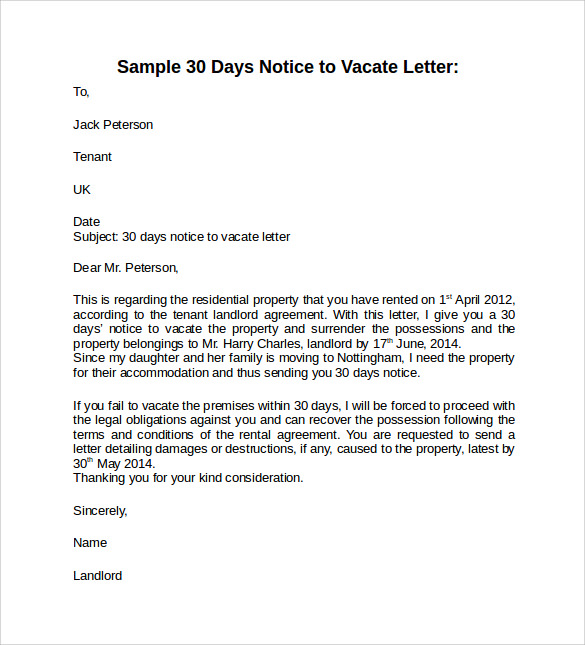Navigating Your Move The Right Way 30-Day Notice
Moving can be a chaotic whirlwind of packing, planning, and paperwork. But amidst the flurry of activity, one crucial step often stands out: providing your landlord with a 30-day notice of your intent to move. This seemingly simple act can be the key to a smooth transition, protecting you from potential legal and financial repercussions. So, why is a 30-day notice so important, and how can you ensure you're doing it right?
Submitting a 30-day notice isn’t just about courtesy; it's often a legal requirement stipulated in most lease agreements. Failing to provide adequate notice can lead to penalties, including forfeiting your security deposit or even being held responsible for paying rent after you've moved out. Understanding the rules surrounding lease termination is vital for protecting your interests during a move.
The concept of a 30-day notice stems from the need to provide landlords with reasonable time to find new tenants, minimizing their financial losses due to vacancy. It also provides tenants with a defined timeframe to prepare for their move, reducing the stress and uncertainty often associated with relocation. This mutual benefit makes the 30-day notice a cornerstone of the landlord-tenant relationship.
Historically, notice periods have varied, but the 30-day timeframe has become the standard in many jurisdictions. This practice helps balance the rights and responsibilities of both landlords and tenants, fostering a more predictable and stable rental market. While the exact requirements can differ based on local laws and specific lease terms, the underlying principle remains the same: providing adequate time for both parties to adjust to the change.
While the concept of providing notice is relatively straightforward, issues can arise. Disagreements over the validity of the notice, disputes regarding lease terms, or unexpected circumstances like early termination clauses can complicate the process. Being aware of these potential complications and understanding your rights and responsibilities is crucial for navigating the process effectively.
Submitting a 30-day notice typically involves a written document clearly stating your intent to vacate the premises by a specific date. This date should be at least 30 days from the date the notice is delivered to your landlord. The notice should include your name, the address of the property, and the date of your intended move-out. While some jurisdictions may accept verbal notification, a written notice provides a clear record and helps avoid disputes.
Providing proper notice offers several benefits. First, it protects your security deposit. Second, it avoids potential legal disputes with your landlord. Third, it helps maintain a positive relationship with your landlord, which can be valuable for future rental references.
Creating an action plan involves reviewing your lease agreement, drafting your notice, delivering it to your landlord in the specified manner (e.g., certified mail, hand delivery), and confirming receipt. Documenting each step is crucial. A successful example would involve a tenant delivering a written notice 35 days before their intended move-out date and receiving confirmation of receipt from their landlord.
Here’s a simple checklist: Review your lease for specific notice requirements, draft a written notice, deliver the notice according to lease instructions, confirm receipt of the notice, and document everything.
Step-by-step guide: 1) Read your lease. 2) Write the notice. 3) Deliver the notice. 4) Confirm receipt. 5) Keep copies of everything.
Advantages and Disadvantages of Giving a 30-Day Notice
Best practices include: Send the notice via certified mail, keep a copy for your records, follow up with your landlord to confirm receipt, be polite and professional in your communication, and understand your lease agreement thoroughly.
FAQs: What if my lease doesn't specify a notice period? What happens if I move out before the 30 days are up? Can my landlord charge me rent after I've moved out if I gave proper notice? How can I prove I gave my landlord notice? What if my landlord doesn't accept my notice? What are my options if I need to break my lease early? Can I get my security deposit back if I don't give 30 days' notice? What are the legal ramifications of not giving proper notice?
Tips and tricks: Consider sending your notice via certified mail with return receipt requested, always communicate in writing, and maintain a respectful and professional relationship with your landlord throughout the process. These steps can help avoid misunderstandings and ensure a smooth transition.
In conclusion, providing a 30-day notice to your landlord is more than just a formality; it's a crucial step in ensuring a smooth and legally sound move-out process. By understanding the importance of this notice, the potential pitfalls of non-compliance, and the best practices for delivering it effectively, you can protect yourself from unnecessary stress, financial penalties, and legal complications. Take the time to plan your move carefully, communicate clearly with your landlord, and follow the steps outlined above to make your next transition as seamless as possible. Your future self will thank you for it. By providing adequate notice, you demonstrate respect for your landlord, adhere to your lease agreement, and set the stage for a positive conclusion to your tenancy. Moving is stressful enough without the added burden of legal disputes or financial losses. Take control of your move, protect your interests, and make the transition to your new home a positive experience.
Unlocking the mystery why does skips skip on regular show
Ea fc 25 release date anticipation
Humana medicare ppo plan comparisons














